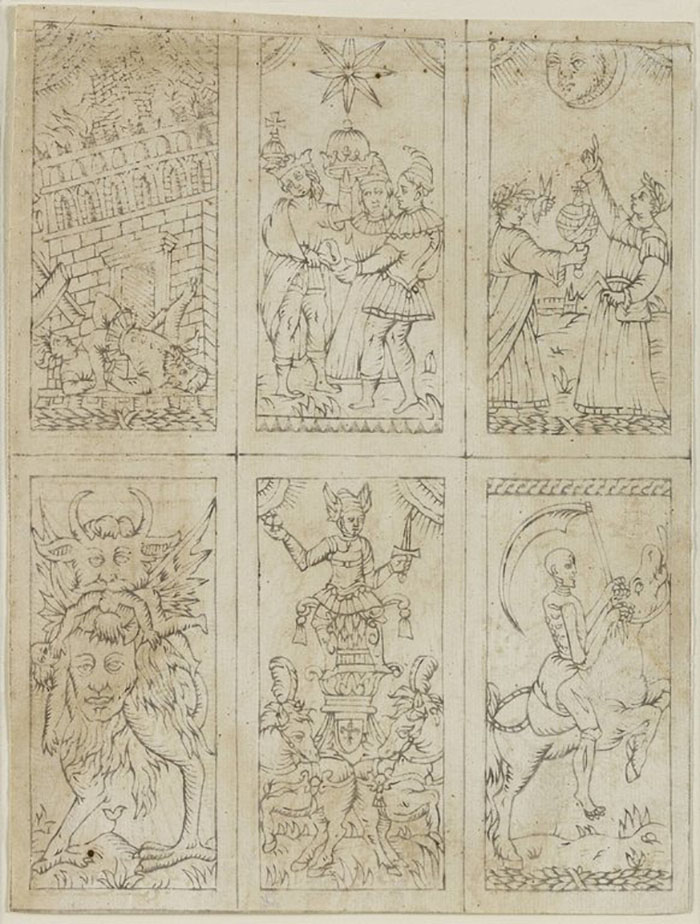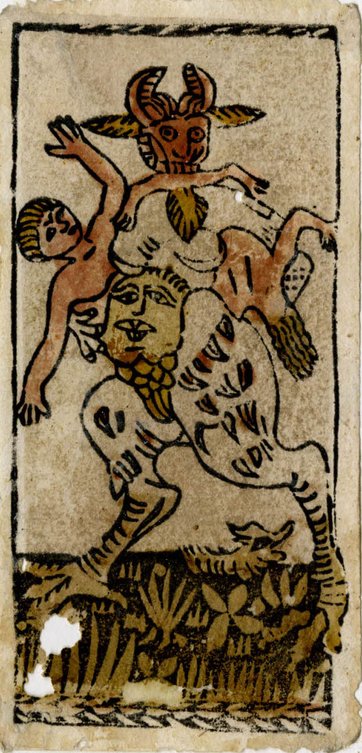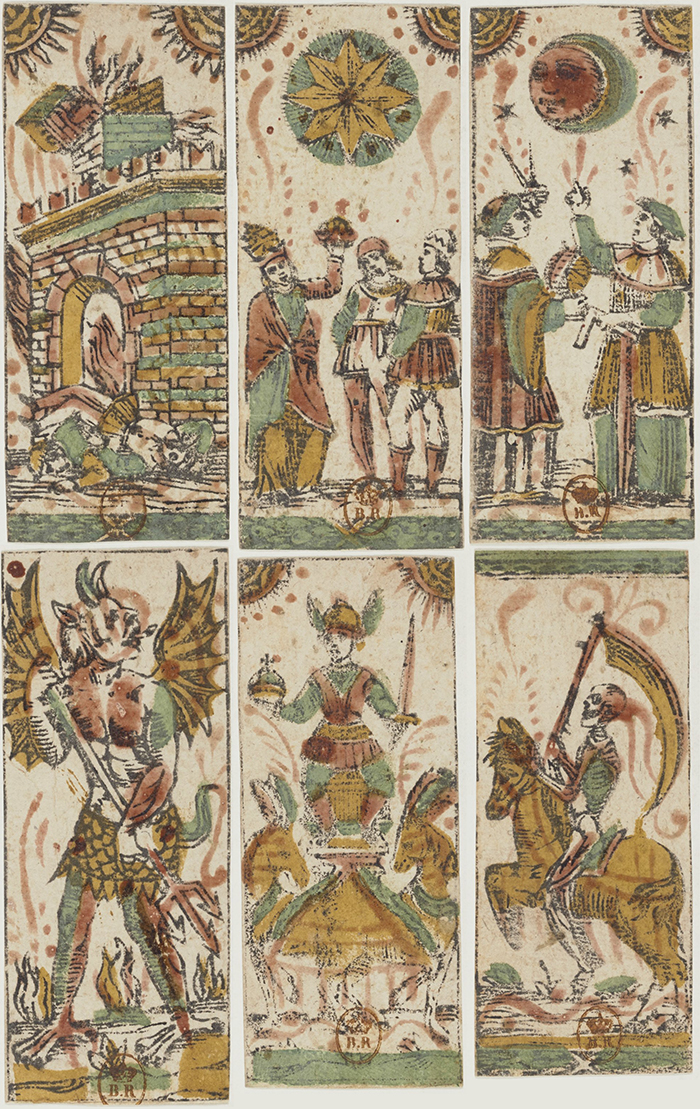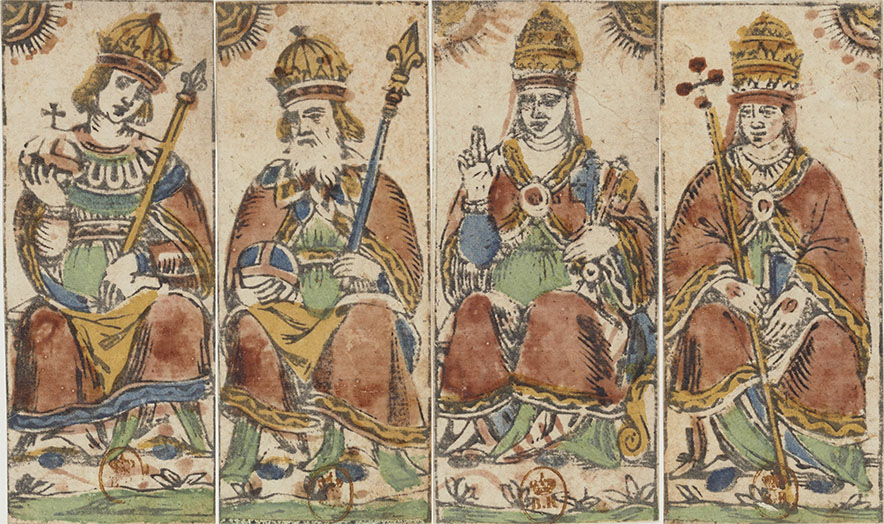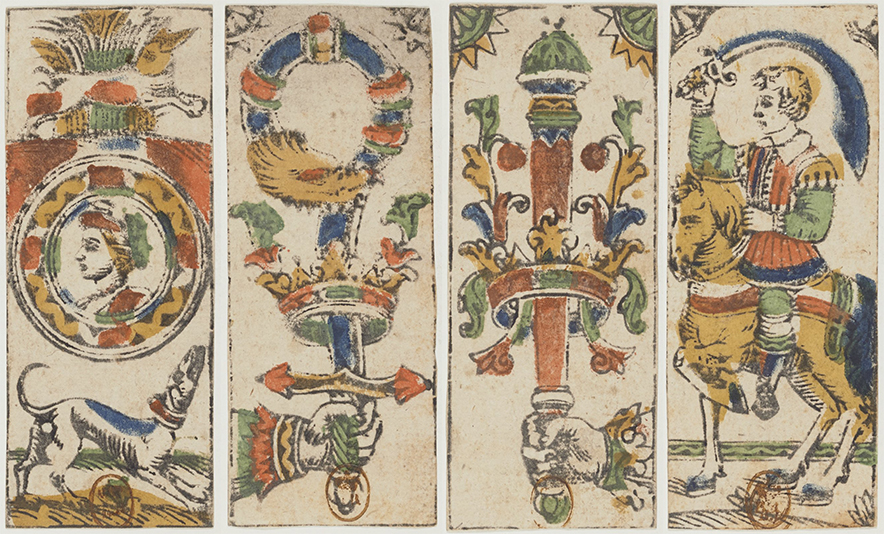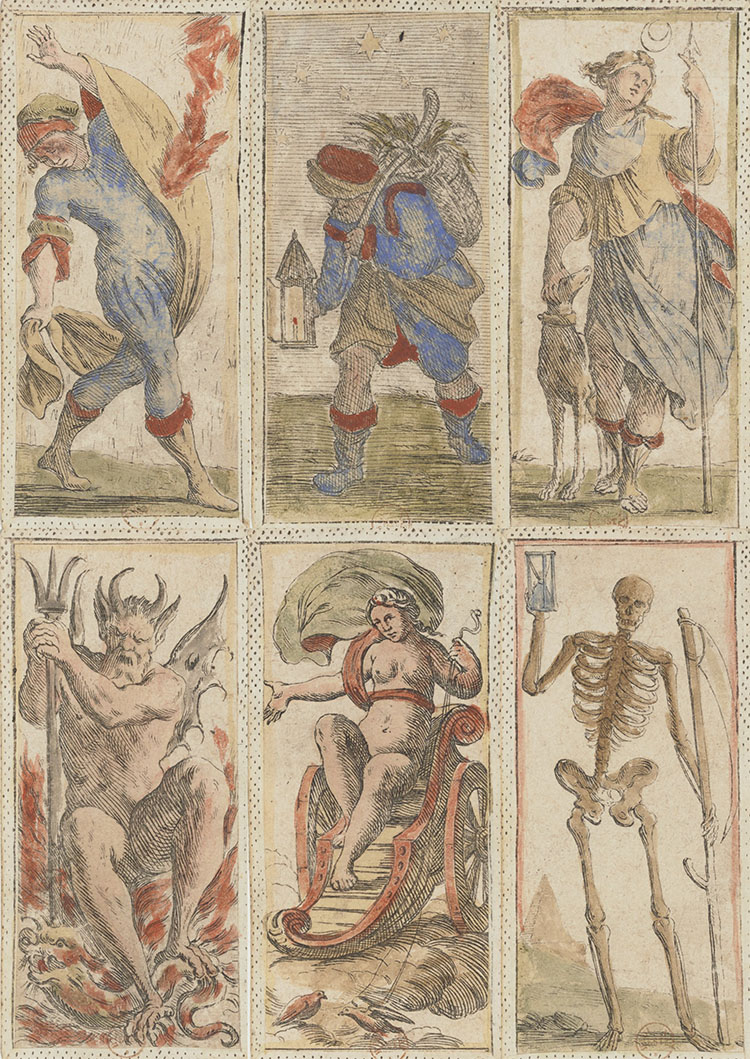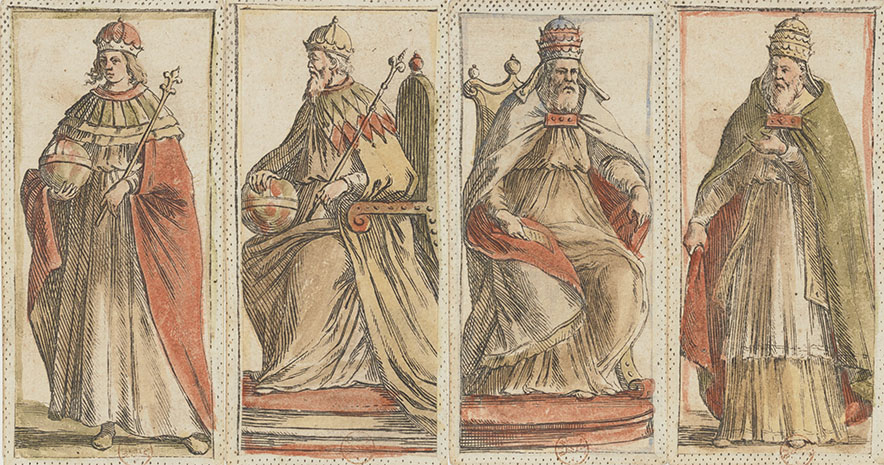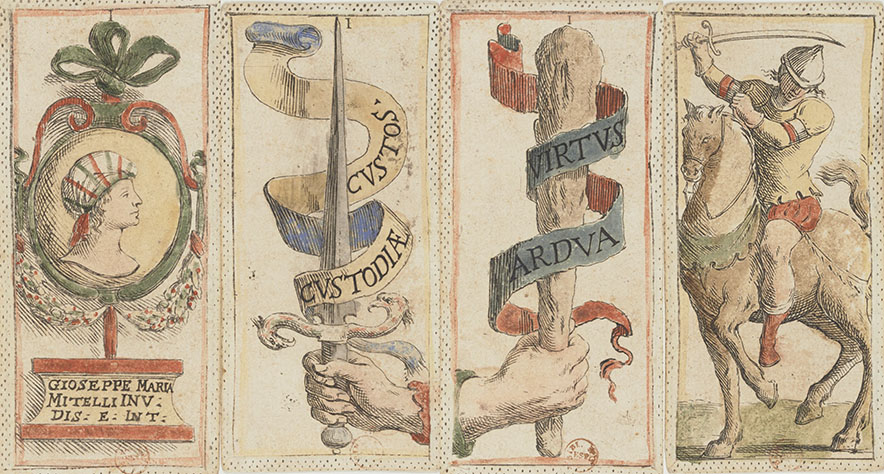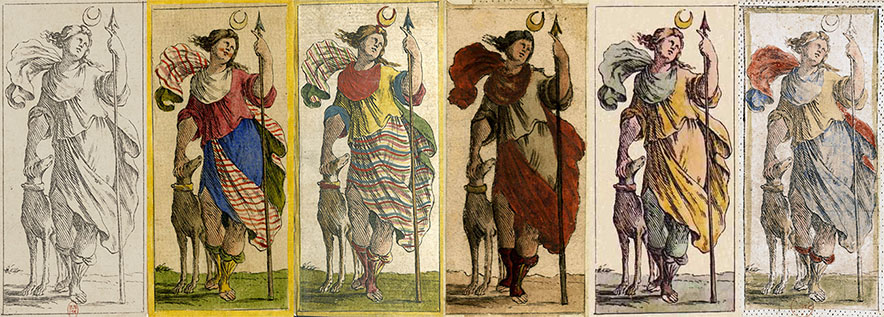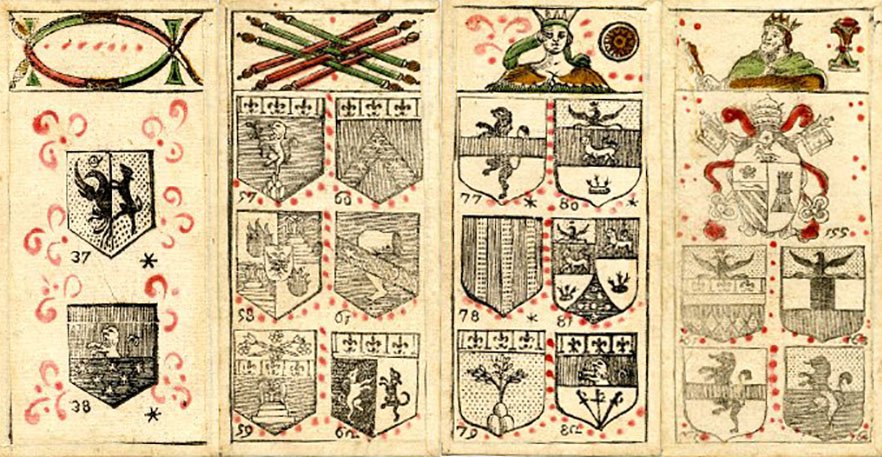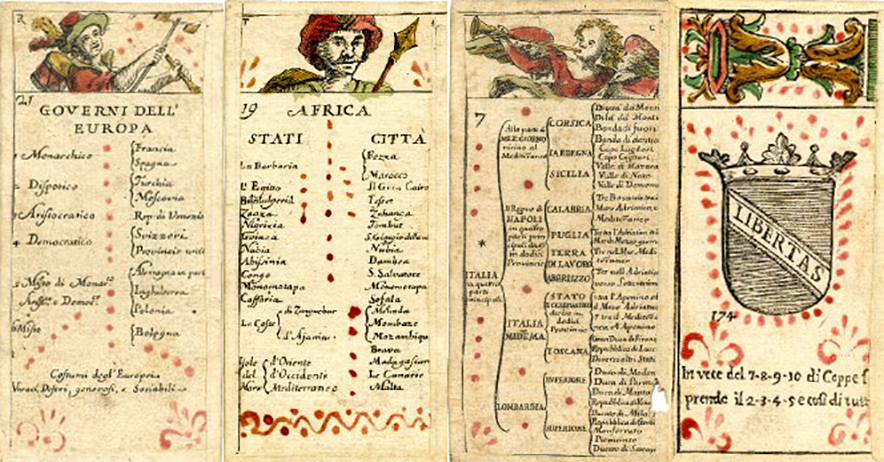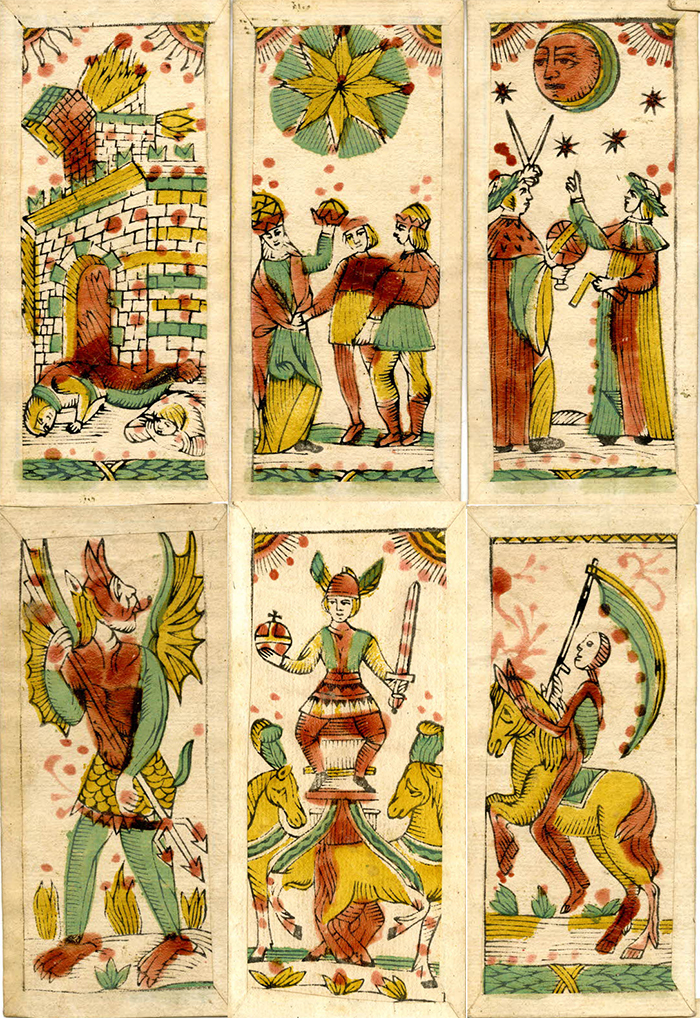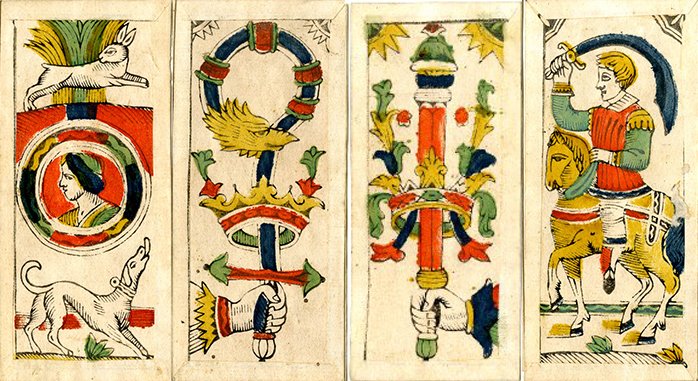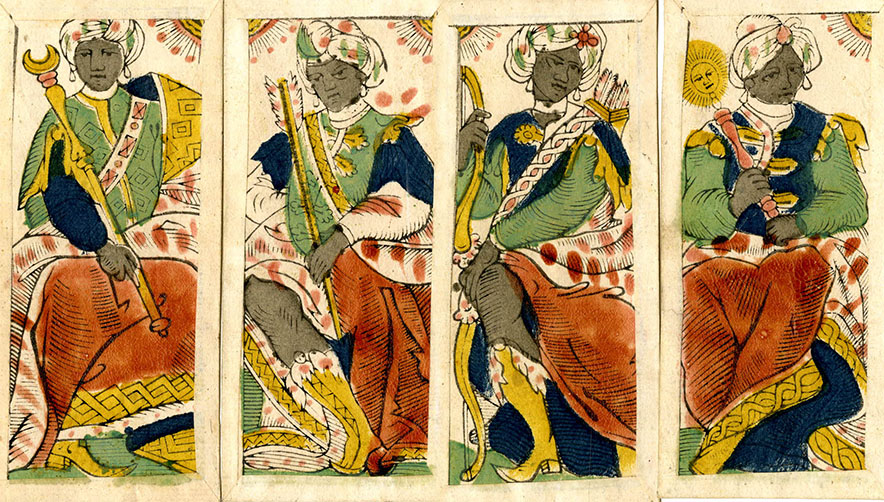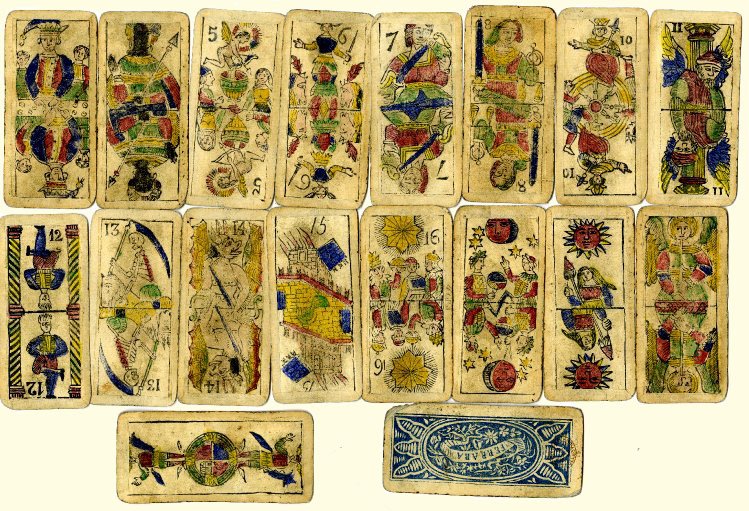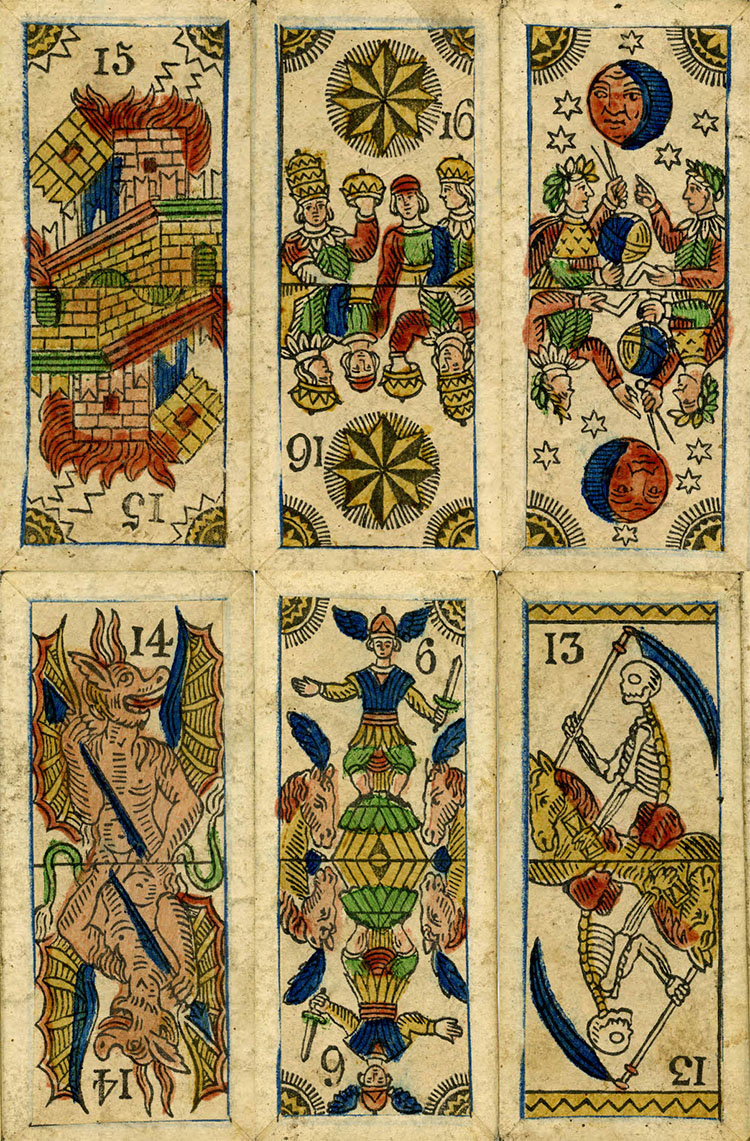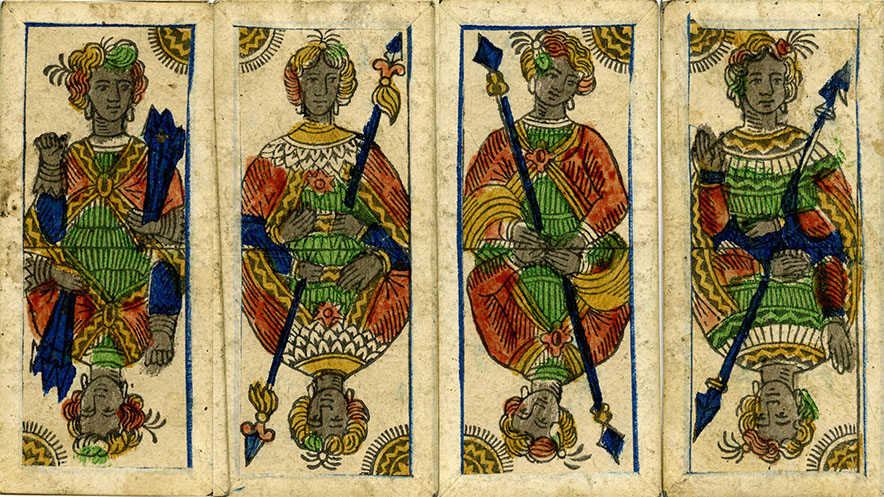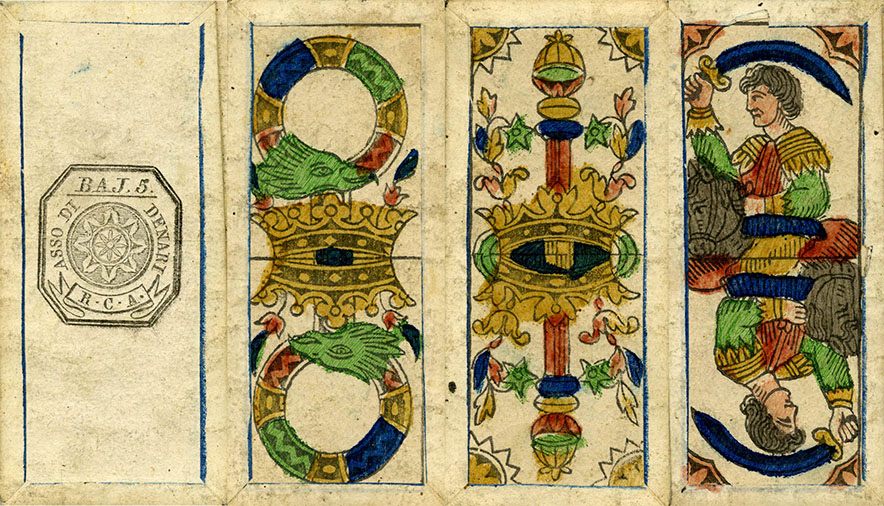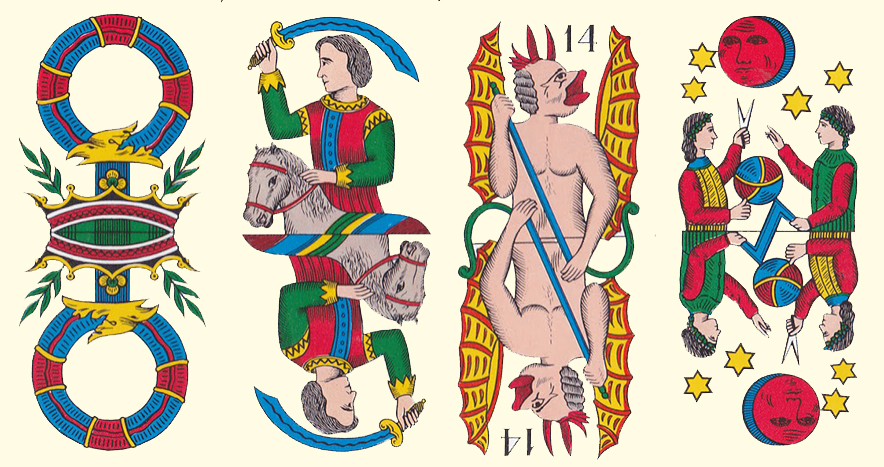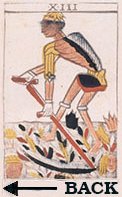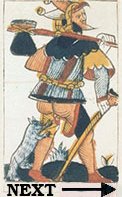THE TAROT WHEEL
THE TAROCCHINO DECK
The Tarocchino is a variation on the Tarocco deck. Tarocco is the Italian word for Tarot, its plural is Tarocchi. The Tarocchino (with as plural Tarocchini) was born in the 15th Century in Bologna, one of the main centers of playing card production in Italy. In the same city, we have also the production of Minchate and Tarocchi decks. The particularity of the Tarocchino game is that the cards from two to five have been removed, with as result that the deck consists of 62 cards, of which 24 pip cards, 16 court cards and 22 trumps. In the 22 trump cards, there is no Popess. She has been replaced by a second Pope. The two Popes, the Empress and the Emperor were known as the four Popes, and instead of calling them by their name they were called Pope 1, Pope 2, Pope 3 and Pope 4. In game playing, these four cards have the same value. In 1725, the four Popes were replaced by four Moors. Why this happened is explained later on this page.
Many books have been written about the Tarocchino, most of them by very eminent experts. I do not consider myself among these experts, so on this page I will only give a brief introduction to the characteristics of the deck and its history. Because history there is. The Tarocchino deck has a long history, starting with its creation in the 15th Century, and continuing until today. The game is still existing and played in a large region around Bologna. The probably oldest surviving Tarocchino cards are the so-called Rothschild sheets, both conserved in Paris, one sheet in the Musée du Louvre in Paris and the other in the library of the Ecole Nationale Supérieure des Beaux Arts. These two sheets have been dated to the late 15th Century. Together, they show twelve trumps. Except for the Devil, these trump card images stayed unchanged until today. Let me show as an example the sheet that is conserved in the Musée du Louvre:
On the top row we have the Tower, the Star and the Moon. On the bottom row we see the Devil, the Chariot and Death. This card of the Devil is maybe modeled to the hand-painted Ferrarese Devil cards. Another similar Devil card, originating from the 16th or 17th Century, and attributed to Angolo Hebreo (Angolo the Jew) can be seen here below:
Like on the Rothschild sheet of the Louvre we see the Devil devouring several humans. This card is the only that will undergo major changes in the Tarocchino decks. In the French National Library in Paris, we have a Tarocchino game dating from the early 17th Century. In the image below, the same six cards are presented, as those that we find on the Rothschild sheet.
We see that except for the Devil, who is presented in a different, less horrific manner, and Death, who is mirrored regarding the Rothschild sheet, the other trumps are virtually identical to the ones depicted on this sheet conserved. These representations of the trumps are characteristic for the Tarocchino di Bologna. And not only the trumps have their characteristic appearance, also on the suit cards, we find some elements that are characteristic for the Tarocchino di Bologna. Especially the aces and the court cards keep, like the Tarot of Marseille, most of their characteristics over the Centuries. However, as we will later see, some cards will change. From the same deck as shown here above, we show on the first row the Empress, the Emperor, the Pope and the Popess (the so-called four Popes). On the next row are presented three of the Aces and the knight of Swords for comparison with later Tarocchino decks.
The Ace of Coins has a dog below,, and a hare above the suit symbol. The Ace of Swords is curved in a circle on top and ends in a Dragon like head. The Ace of Batons is like the Ace of Swords passing through a Crown. The Crown is situated much lower than on the corresponding TdM cards. The Knight of Swords has a very typical curved swords, all other court members have a straight sword. The characteristics of these cards and of all other suit cards did not change over the ages.
Somewhere between 1660 and 1670 the Bologna-based painter and engraver Giuseppe Maria Mitelli designs a deck of cards in order of the rich Bolognese family Bentivoglio, respecting the structure of the Tarocchino, but with all cards redesigned. The Tarocchino di Mitelli, as it is called, is very different in the representation of the 22 allegorical figures compared with a standard Tarocchino deck. Here below, I show the same six cards as appearing on the Rothschild sheet for comparison.
The images have really nothing to do with the standard Tarocchino deck. Even the suit cards are different. Still, the images respect the symbolism behind the Tarot cards, with as only difference that there are two Popes and no Popess. The Mitelli deck will later be produced by other Bolognese card makers, like the 1803 deck of Francesco Baratinni.
Here below we see first the four Popes of the Mitelli deck, followed by the same three aces and the knight of Sword as shown for the other Tarocchino decks, to show that differences between these two Tarocchino versions were not limited to the trump cards.
Mitelli made only a black and white deck, it was up to his client to have the cards colored. The cards shown here above belong to a deck that is conserved in the French National Library. However, there are as many colored versions of this deck, as there are decks that survived time. To illustrate this, I show here below the card representing the Moon. The first card is the original uncolored version, next to this card five different colored versions. All these cards are from original Mitelli prints, colored at the epoch. The rightmost card is from the deck that I used earlier on this page, to highlight the differences between the Mitelli and the standard Tarocchini decks.
In 1725 something happened that would have a big impact on the Tarocchino decks, with the Empress, Emperor, Popess and Pope replaced by four Moorish figures. A certain Luigi Montieri produced in 1722 a variant of the Tarocchino deck with on each card geographic (the trump cards) and heraldic (the suit cards) information. On the suit cards he placed as many heraldic shields as the suit number indicated, so one shield on the Ace, six shields on the card numbered six, and so on. For the numbers higher than the suit number six, it was very difficult to put recognizable shields on the cards. With 7, 8, 9 or 10 shields on the same cards, the heraldic elements would probably become unrecognizable. To have sufficient space to put the heraldic shields on the cards, he removed the cards numbered 7 unto the 10 to replace them with the cards numbered 2 to 5, that are originally not used on the Tarocchino deck. As a consequence, we have a deck with the suit numbers of one to six. The result is a deck that has the same size as the Tarocchino deck, with 24 pip cards, 16 court cards and 22 trumps (62 cards in total), but with different pip cards. On every court card, six heraldic shields are shown except for the King, that is having four shields of a standard size with one bigger Royal (or Papal) shield. Here below as example the Two of Swords, the Six of Batons, the Queen of Coins and the King of Cups.
On the 22nd trump card, the Fool, appeared a list of European states with their type of government. On this list figured the city state of Bologna, and on this list the government form is indicated as mixed (Misto). Officially, Bologna was one of the Papal States. When the Pope heard about this card, he became furious. As a result, the Papal Legate, Cardinal Tomasso Ruffo threw Montieri and his staff in prison. Within a couple of days, he had to release them to avoid troubles in town. Bologna was very attached to its liberties. To save his face, he ordered that the four Popes in the deck (the Emperor, Empress and the two Popes) should be replaced by four Moors. The Angel should also be replaced by a Lady. From this date, all Tarocchino decks show four Moors instead of four Popes. However, the Angel was conserved, to emphasize the liberties of Bologna, and worse, on the next Montieri deck, that he published in 1725, the Fool keeps the mention of Bologna as having a mixed government. Here below four other cards of this non-standard deck, that had such a big influence on the standard ones. The example below consists of the Fool, one of the four Moors, the Angel that is still present and the Ace of Cups, on which card it is indicated that the cards numbered 7 to 10, replace the original cards numbered 2 to 5. Because we have a Moor on the second card, we know that this particular deck is a replacement deck for the original version of 1722.
On the card, we see on the image part on top in the upper-left corner a character in capitals. In the Geographic part we see on the same place a number. The order indicated by the numbers is quite strange. But if we follow the classical Bologna order the capitals begin to speak. Here below the cards in the Bolognese order with the numbers and the Capitals that are marked on the cards.
R 21 Fool
O 22 Magician
T 19 Moor
N 20 Moor
E 18 Moor
V 05 Moor
N 01 Lovers
I 04 Chariot
I 17 Temperance
R 02 Justice
E 03 Strength
I 13 Wheel of Fortune
T 12 Time
N 11 Hanged Man
O 09 Death
M 15 Devil
I 16 Tower
G 14 Star
I 06 Moon
U 08 Sun
L 10 World
C 07 Angel
The numbers do not make any sens for me at this moment, but the capitals do. If we read them backwards, from the Angel to the Fool, we see CLUIGIMONTIERIINVENTOR. The first C is an abbreviation for Canon. Putting the spaces where needed and expanding the C, we read Canon Luigi Montieri Inventor, the signature of Luigi Montieri who created this deck.
The next deck I will show is a standard Tarocchino deck, created by Antonio de Maria in the early 18th Century in Bologna, this time with the four Moors present. Here below we see the same cards as on the Rothschild sheet from the same deck as the four Moors presented on the Introduction to the cousins of the Tarot page. This particular deck, is conserved in the British Museum.
The cards date from somewhere between 1725 and 1770. We remark that the trumps are still not numbered. In fact, the Tarocchino deck was one of the last to introduce numbering. The trump cards are identical to those on the Tarocchino deck conserved in the French National Library, presented earlier on this page. To complete the comparison, we will first show again the four Moors followed by the three Aces and the Knight of Swords, like we have shown for the deck conserved in the French National Library.
The Sun and the Moon are respectively male and female symbols, so the Moor on the right, holding the Sun in his hand, represents the Emperor. The leftmost card, where you see a Moor with a Moon in her hand, is representing the Empress. In biblical symbolism, bows and arrows represent the doctrine of truth, where the bows represent the doctrine and the arrows the truth. As such, the Moor with the bow represents the Pope and the Moor with the arrow in her hand the Popess. Remark also that in Italian, the word arco (bow) is masculine and the word freccia (arrow) feminine.
Except for the Moors, the suit cards are also identical to the previously presented early 17th Century deck conserved in Paris.vWhat is perfectly clear from the cards here above, the 15th Century Rothschild sheet conserved in the Louvre, the deck conserved in the French National Library and the 18th Century Tarocchino di Bologna conserved in the British Museum, is that the Tarocchino is the oldest standard pattern in the Tarot family. The Tarocchino pattern predates the Tarot of Marseille with at least one -and-a-half century, and it had been virtually unchanged for over three Centuries at the moment that Nicolas Conver published his version of the Marseille Tarot.
Somewhere between 1760 and 1780 the Tarocchino di Bologna underwent two major changes. To facilitate game playing, the cards became double-headed and the trumps from 5 (the Lovers) to 16 (the Star) were numbered on the cards with standard Arabic numerals. Only clones of the Mitelli decks did not adopt these changes. One of the earliest (partly) surviving Tarocchino decks, made in the 18th Century and having these double-headed cards, were not published in Bologna, but in Ferrara by a certain Cassini. On the next figure are presented the surviving Cassini trumpcards.
We clearly recognize all trumps. The images have been adapted to the double representation, but without any other changes when compared with the older decks. The numbers on the cards indicate the (Bologna) order. The lowest and highest cards are still not numbered.
As a last historical deck, we will show a Tarocchino deck from the early 19th Century. The Page of Swords has the characters G.M. on his shield, indicating the name of the card maker. We first show the same six cards as on the Rothschild sheet, followed by the same suit cards as we showed for the other Tarocchino decks.
Except for the Devil, the cards still are respecting the image composition as present on the Rothschildt sheet. the Devil is identical to the two centuries older Tarocchino deck conserved in the French National Library (BNF). The same can be said of the suit cards of which the same four cards are presented here as as we presented of the BNF deck, preceded by the four Moors.
The Ace of Coins has been modified. Instead of the traditional Ace of Coins, we have here an empty card with the tax stamp on it. The images here above are two centuries old. And the Tarocchino did not change. It is still existing and played according virtually the same rules as in the 15th Century. As such, the Tarocchino is the longest living game of the Tarot family. To finish this page, here below four cards of a modern deck, still used today to play the game of Tarocchino in the region around Bologna. We see the Ace of Swords, the Knight of Swords, the Devil and the Moon. Nothing essential changed since over five Centuries. Despite technical changes, symbolism stayed the same and game rules stayed the same. Tarocchino was born well before the Tarot of Marseille, and the game survived well after the game played with the Tarot of Marseille disappeared. Today, nobody uses the Tarot of Marseille for game playing. Tarocchino is still a game, with identical rules as in the late 15th Century. Who can do better?
